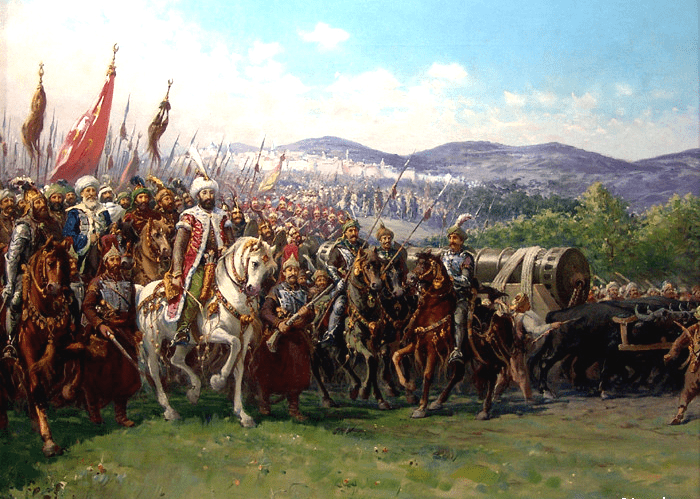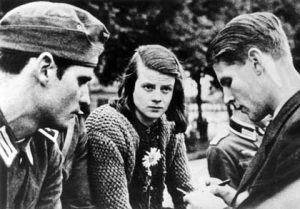How do you beat a good defense? By having a better offense. In the year 1453, one of the greatest showcases of artillery advancement in history took place. There were two groups in conflict, each known for a strength opposite the other: one was known for its indestructible defensive walls, and the other known for its weapons of assault. These two sides were the Byzantines and the Ottomans. The event bringing them together was siege of the Byzantine capital Constantinople. The aftermath of this siege was the recognition of the Ottomans as a new major power in the world. Their victory over the Byzantine Empire, heir to the ancient Roman Empire, marked the waning of the Middle Ages and the early dawning of a new age to come, the Early Modern era.

Mehmed II was the ruler of the Ottoman people when he seized control of the Byzantine Empire. At age eighteen, when he first got power, there was a backlash within the ranks of his commanders. Mehmed II was forced out of power. His father, Mehmed I, had to help his son regain his power. This event fueled Mehmed II’s sense of conquering, having been betrayed by his own people for power.1 The Ottoman army was known as one of the first groups to use gunpowder. In their military attacks, it was a clash of great defense versus a great offense. At the age of twenty-one, Mehmed II lead a military attack against the Byzantine Empire with a weapon known as the Orban cannon, the biggest cannon ever seen in the medieval world. The measurements of this unique cannon were about 27 feet long. It was walled with 8 inches of solid bronze and had a diameter of 30 inches. The target was the unbreakable walls of Constantinople, which the maker of the cannon had had a great deal of time studying. Constantinople was the yet-unconquered capital, and for over a thousand years it had only been captured once, in 1204. The Ottomans saw it as a perfect capital for the empire they hoped to rule. The walls, however, posed a great problem for any foreign invader, because of their height and depth. Therefore, Mehmed II had this special cannon built. The rest of the Byzantine Empire had already been conquered by the Ottomans, and Constantinople was the last remaining piece to be taken.2
The architect behind the destructive cannon was a man named Orban. There is not much information on his earlier life. We have very little information about him regarding the creation of his cannons. Orban was a Hungarian cannon maker. He was opportunistic. No matter who employed him, he just wanted to create the next big cannon. He first began his campaign at the unconquered city of Constantinople, stopping there to sell his services and ideas to Emperor Constantine XI. He liked Orban’s idea for a super-weapon cannon, but he was not willing to offer him much funding for the project. Growing frustrated with Constantine’s financial support, Orban decided to go to the opposing force in the war. He went to see Mehmed II and offer him his services. When the two met, “Mehmed asked Orban if he could cast a cannon large enough to smash the walls of Constantinople.” Orban replied with “I can cast a cannon of bronze with the capacity of the stone you want. I have examined the walls of the city in great detail. I can shatter to dust not only these walls with the stones from my gun, but the very walls of Babylon.”3 Orban proceeded to work on the cannons, and once he was finished, Mehmed ordered a test shot in front of his palace. The test was amazing. The cannon shot its projectile over a mile. The fear it then would strike into the opponent’s hearts was incomparable to anything known. The sheer power of the weapon was terrifying.

With the final product finished, the hard part began: the transportation of the cannon for a trip of 140 miles to the destination. The moving team was quite impressive. With 200 men and 60 oxen, it took six weeks for the guns to arrive, along with 80,000 soldiers all under the command of Mehmed II.4 His men cleared the tree lines and anything else in its path for a clear shot at the wall. An eyewitness of the battle described the destruction of the cannon: “sometimes it would destroy a complete portion of the wall.”3 This was the beginning of the end for the most indestructible object in the world. Mehmed II was ruthless in his tactics, cutting off all escape routes and all incoming supplies. The result was a 53-day siege, leaving the walls in ruins.

This, the dawn of the gunpowder era, spelled the end of the Middle Ages and the beginning of a new age of warfare. The effects of this battle saw a major change in the modern army’s artillery and the use of gunpowder for armys around the world. The recognition of the Ottoman Empire as a world power increased after this war, along with Mehmed II’s reputation in the empire.
- Charles Foster, “The fall of Constantinople and the end of an empire,” Contemporary Review Vol. 288 Issue 1682 (Autumn 2006): 379. ↵
- Franz Babinger, Mehmed the Conqueror and His Time (New Jersey: Princeton University Press, 1978), 85. ↵
- Roger Crowley, “The guns of Constantinople: history’s first great artillery barrage, in 1453, shattered the Byzantine capital and changed warfare forever,” Military History Vol. 24 Issue 6 (Sept 2007): 44. ↵
- World History Encyclopedia, 2011, s.v. “The Ottomans as a Gunpowder Empire,” by Alfred J. Andrea and Carolyn Neel. ↵
- Roger Crowley, “The guns of Constantinople: history’s first great artillery barrage, in 1453, shattered the Byzantine capital and changed warfare forever,” Military History Vol. 24 Issue 6 (Sept 2007): 44. ↵



43 comments
Rebekah Esquivel
I really liked how the writer started this article by having a question, answering it, and then going on to continue with the topic of this article. It was definitely a good way to keep me interested, wondering what that question really had to do with the topic of the article itself. I found it pretty interesting how a canon that big was made in the middle ages. This article provided a great amount of detail that taught me a lot about Constantinople. Without reading this, I probably would never have known about this story.
Megan Barnett
I thought it was very interesting to learn where this certain type of warfare began. The author did a great job of describing the Orban Cannon, how it came about, and where it was used. However, I feel that there was not much of the article that was grabbing my attention as a reader aside from the pictures that were included.
Mario Sosa
Very fascinating article, as I have wondered how the Ottoman empire was able to successfully take control of Constantinople. It’s a shame that the Byzantine emperor didn’t finance Orban, since it was his cannon that would eventually lead to the end of the Byzantine empire. With a cannon that has a mile long firing radius, it can be said with certainty that the Byzantine’s Greek fire would not have helped them this time. Excellent article, good work!
Robert Rees
I had always wondered how the Ottoman Empire came to be considered a major European power. This article does an excellent job of showing just how this happened. I would say this article’s only real flaw is that it comes off as being another encyclopedia article. However, there is enough referencing to the old conundrum of which would win in a fight, an impenetrable shield or a spear that can pierce anything, to make this article an enjoyable read.
Crystalrose Quintero
I enjoyed how they started the article by posing a question, giving an answer and then proceeding to describe an example. I enjoyed that the article was descriptive in all its facts such as indicating the creator of cannons used for war. The quote by Orban really brought the article to life. The concluding paragraph was a perfect closing for the article and was written in an accessible manner.
Josselyn Arrieta-Meraz
I wasn’t aware of this event until after reading this article of the fall of Constantinople. It is really refreshing to think how sometimes we believe that many of the modern object he have now in days were actually adapted or known way before in history. We underestimate the power others had at the time and this article serves as a reminder of even that sometimes seem hard to believe but are true events, like the decision of hitting the wall, and the over all transportation of the cannon.
Ernie Sano
I always enjoy stories involving the military. Strategy and wit always make for a wonderful tale. Exploring the creativity and madness of the human mind is something that can always be appreciated. Individuals providing means to destroying an entire civilization shows that the mind is able to explore realms of superiority that surpass hundreds of thousands of people.
Osman Rodriguez
This article caught my eye because of the name of Constantinople. I have heard the name of the city before, yet I did not know of their defensive prowess. When it comes to the Ottoman empire, I have also heard about them, but I actually don’t know anything about them. Learning new things about these particular subjects was great. It is interesting to know where the cannon was revolutionized and the significance of it, back in those time.
Soteria Banks
This was a good article over all. I love the title its very dramatic. it pulls you in and makes you want to read the his story and also the featured image is a very good one. I didn’t know canons had so much history. When you think about it its like when we discovered the atomic bomb and other destructive weapons,it was a big deal. Its seems useless now , but back then I bet it was very useful.
Alexandria Martinez
This was an informative article, the creation of this cannon was revolutionary for the Ottoman Empire. Technology is always advancing and new and better things are always being created. The proof is in this article, a technology was required in order to conquer the city so there needed to be some new ideas and creations. Humans have always been able to create many things and keep creating better tech than what was once the best.